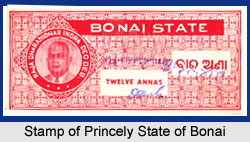 The Princely State of Bonai was amongst the major native states during the rule of the British Empire in India. During the early 19th century, the region was assigned as one of the princely states of India under the indirect rule of the British administration. The territory covered a total area of 8,907 sq km and comprised of a total population of 24,026 in the year 1892. The population was primarily Oriya speaking. The native was incorporated as a part of the Orissa States Agency, which was under the administrative control of the Eastern States Agency. The former princely state of Bonai was acceded to the newly formed Dominion of India on 15th April 1948, after the nation gained independence.
The Princely State of Bonai was amongst the major native states during the rule of the British Empire in India. During the early 19th century, the region was assigned as one of the princely states of India under the indirect rule of the British administration. The territory covered a total area of 8,907 sq km and comprised of a total population of 24,026 in the year 1892. The population was primarily Oriya speaking. The native was incorporated as a part of the Orissa States Agency, which was under the administrative control of the Eastern States Agency. The former princely state of Bonai was acceded to the newly formed Dominion of India on 15th April 1948, after the nation gained independence.
History of Princely State of Bonai
The native ruler of the princely state held the title of Raja. The Rathore dynasty was the ruling family of the princely state of Bonai. The native rulers of Bonai state shared paternal ancestry with the rulers of the state of Rairakhol, Seraikhella and Kharsawan. The title of Tikait was the courtesy title of the heir apparent and the title of Patait was borne by the second son. The third son held the title of Lal by the third son and the younger sons held the style Babu. The rule of male primogeniture, by which the first born or eldest child of the same parents had the right, by law or custom, to inherit the entire estate of one or both parents, to the exclusion of all others, was followed in the succession of the throne or gadi of the princely state.
Administration of Princely State of Bonai
Bonai state was mainly a non salute state of India and was also a non jurisdictionary native state. The Raja of Bonai state exercised limited civil and criminal jurisdiction, which was subject to the general restrictions related to capital offenses. The princely state of Bonai was one of the original constituent members of the Chamber of Princes, a number of smaller states indirectly represented by 12 princes who were elected periodically by them.
Accession of Princely State of Bonai
When the country achieved independence after the political withdrawal of the British Government of India on 15th August 1947, the nation was segregated between India and Pakistan through the Partition of India. The native rulers of the princely states of India were given the option of acceding to either the Union of India or the Dominion of Pakistan. The native shareholders of the princely state of Bonai decided to accede his state to the newly formed Union of India. At present, the region is incorporated as a part of the Indian state in Orissa state.
Rulers of Princely State of Bonai
The chronology of the native rulers of the princely state of Bonai are mentioned as follows-
* Raja Dayanidhi Chandra Deo (1804- 1851)
* Raja Chandra Deo (1851- 1876)
* Raja Indra Deo Bahadur (1876- 1898)
* Raja Nilambar Chandra Deo (1898- 1902)
* Raja Dharani Dhar Deo Deb (1902)
* Raja Saheb Kadamba Keshri Chandra Deo



















